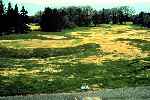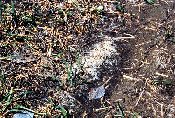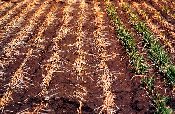| | Biology | Damage description | Diagnosis | Management strategy
Cottony snow mold - Coprinus psychromorbidus (LTB and SLTB phase)
Gray snow mold - Typhula incarnata
Pink snow mold - Fusarium nivale
Speckled snow mold - Typhula ishikariensis var. ishikariensis, T. ishikariensis var. canadensis
Sclerotinia snow mold - Myriosclerotinia borealis
Biology
An important cause of winter wheat damage in Alberta is winter injury or winterkill; these are terms used to describe damage from disease or environmental stress. All cold hardy winter wheat varieties are susceptible to several snow mold fungi. These fungi cause severe damage under snow cover during conditions that are favorable for disease development. Cottony snow mold fungi are found throughout Alberta, while sclerotinia snow mold is common in the central and northern areas. This fungus can cause damage under snow-covered frozen soil.

When there is little or no snow cover, winter wheat can be damaged by environmental stresses, including subfreezing temperatures, standing water, ice encasement, heaving and desiccation. In southern Alberta, warm chinook winds may melt the protective snow cover and cause decreased hardiness of plants and expose them to drying winds and frosts.
These fungi overwinter as sclerotes (tiny black structures that are the overwintering bodies) or as a fungus in soil or crop residue. Some fungi, such as S. borealis, are an endemic disease of wild grasses. Each snow mold has a specific geographic distribution on the prairies and characteristic environmental factors that favor its growth.
Snow molds cause the most damage when an early snow storm covers unfrozen soil and snow persists throughout the winter, maintaining high humidity and temperatures of about 0 degrees Celsius at soil level. Snow molds grow quite actively at temperatures near freezing.
Damage Description
Because of the complexity of the causal factors, the diagnosis of winter damage is difficult when growth resumes in the spring. Damage is often assessed on the basis of symptoms and a knowledge of the terrain, soil conditions, management practices and weather. Injury from standing water and ice encasement take place in heavy or poorly-drained soils when freeze-thaw cycles and rain occur during the winter. Desiccation injury often occurs on exposed hills and on bare, wind-swept fields. Damage from snow molds is most prevalent and severe following a long, snowy winter, especially where snow has accumulated in drifts. Damage from snow mold may occur in discrete patches, in large areas, or may cause thinning of the stand within the rows.
Winter injury may range from one or two dead tillers per plant to large areas of dead plants within each field. In 1983, snow molds destroyed 80 per cent of the fall rye in the Peace River region.
Diagnosis
Five or more plants per square metre must remain alive to produce an average crop yield. As long as the cereal crowns remain alive, new leaves and roots can be regenerated.
Examine fall seeded crops in April. A quick way to determine if plants are alive is to remove some sample crowns from the field, place them in a closed plastic bag and leave them in a warm room. Crown tissue that is severely damaged will quickly turn brown in a day or so, while healthy tissue remains white.
Management Strategy and Control
Use tolerant varieties and produce an environment unfavorable for the disease organism.
- Cultivars of hard red winter wheat recommended for southern Alberta are more tolerant to ice encasement than those grown elsewhere.
- Do not plant winter wheat too late in the season. Plant resistance to winter injury depends largely on whether enough carbohydrate reserves have accumulated in the crown and whether the plants are fully cold hardened before the onset of winter. The last week of August and the first week of September are considered the ideal planting times.
- Avoid heavy applications of nitrogen in the fall. Use adequate amounts of phosphorus for vigorous root growth.
- Seed into stubble to help trap a light protective cover of snow. Ten centimetres of unpacked snow can prevent soil temperatures from falling below -11 degrees Celsius, even during the coldest periods of winter.
- Seed less than 4 cm deep into a firm moist seedbed.

Cottony snow mold fungus on winter rye - following snow cover melt in the spring.

Winter kill of wheat. Winter wheat may be killed by very low temperatures (lack of snow cover) or killed by snow mold fungi that thrive under the snow particularly under prolonged spring snow cover. |
|